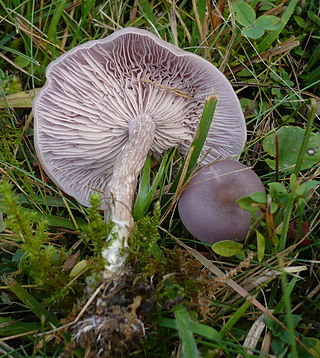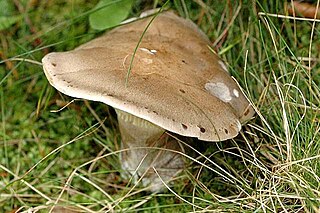
Collybia nuda, commonly known as the blewit or wood blewit and previously described as Lepista nuda and Clitocybe nuda, is an edible mushroom native to Europe and North America. Described by Pierre Bulliard in 1790, it was also known as Tricholoma nudum for many years. It is found in both coniferous and deciduous woodlands. It is a fairly distinctive mushroom that is widely eaten. It has been cultivated in Britain, the Netherlands and France. This species was reassigned to the genus Collybia in 2023.

Blewit refers to two closely related species of edible agarics in the genus Collybia, the wood blewit and the field blewit or blue-leg.

Lepista is a genus of mushroom-forming fungi. According to the Dictionary of the Fungi, the widespread genus contains approximately 50 species. In 1969, Howard Bigelow and Alex H. Smith designated the group as subgenus of Clitocybe.

Collybia personata is a species of edible fungus commonly found growing in grassy areas across Europe and is morphologically related to the wood blewit Collybia nuda. This mushroom was moved to the genus Collybia in 2023.

Clitocybe nebularis or Lepista nebularis, commonly known as the clouded agaric, cloudy clitocybe, or cloud funnel, is an abundant gilled fungus which appears both in conifer-dominated forests and broad-leaved woodland in Europe and North America. Appearing in Britain from mid to late autumn, it is edible, but may cause gastrointestinal issues.

Károly Kalchbrenner was a Hungarian mycologist. He trained in theology early in life and became a priest in Spišské Vlachy, north-eastern Slovakia. His contributions include the publication of 60 papers and description of more than 400 fungi from Europe, Asia, Australia and South America. He wrote and illustrated the Icones Selectae Hymenomycetum Hungariae. Among those he later collaborated with are Ferdinand von Mueller in Victoria, Australia, John Medley Wood in South Africa, Mordecai Cubitt Cooke in England and Felix von Thümen in Austria. He was elected a full member of the Hungarian Academy of Sciences, and a corresponding member of the Linnean Society of New South Wales.
Lepista is a genus of moths in the subfamily Arctiinae. The genus was described by Wallengren in 1863.
Archilema subumbrata is a moth of the subfamily Arctiinae. It was described by William Jacob Holland in 1893, originally under the genus Lepista. It is found in Gabon and Nigeria.
Lepista arabica is a moth of the subfamily Arctiinae. It was described by Rebel in 1907. It is found in Eritrea, Oman and Yemen.
Lepista pandula is a moth of the subfamily Arctiinae. It was described by Jean Baptiste Boisduval in 1847. It is found in Kenya, Malawi, Mozambique, Somalia, South Africa, Tanzania and Uganda.
Lepista pulverulenta is a moth of the subfamily Arctiinae. It was described by Thomas Pennington Lucas in 1890. It is found in Australia, where it has been recorded from Queensland.
Lepista aposema is a moth of the subfamily Arctiinae. It was described by Lars Kühne in 2010. It is found in Mozambique, South Africa, Eswatini and Zimbabwe.

Collybia sordida, formerly Lepista sordida, is a species of blewit mushroom found across the Northern Hemisphere. It is known to form fairy rings.

Paralepista flaccida is a species of mushroom found across the Northern Hemisphere. It is known to form fairy rings.

Paralepista is a genus of mushrooms in family Tricholomataceae. Until 2012, its member species were generally assigned either to Lepista or to Clitocybe.

Lepista luscina is a species of fungus belonging to the family Tricholomataceae.

Lepista panaeolus is a species of fungus belonging to the family Tricholomataceae.

Lepista irina is a species of fungus belonging to the family Tricholomataceae. It is a choice edible mushroom.










